Our header image comes from the #StandUp4Migrants campaign. Find it here.
Download the PDF version of this Policy Note here.
Migration is an integral part of the human story. More than 281 million people live outside their country of birth, and migrants make up 3.6 per cent of the world’s population. Migrants are our neighbours, our co-workers, and, often, they are us. Migrants and migration touch every part of the modern economy and are pillars of society. In recent years, it has also been a visible topic in the political and public discourse. It is no wonder, then, that migration is a high priority for many organisations working on development.
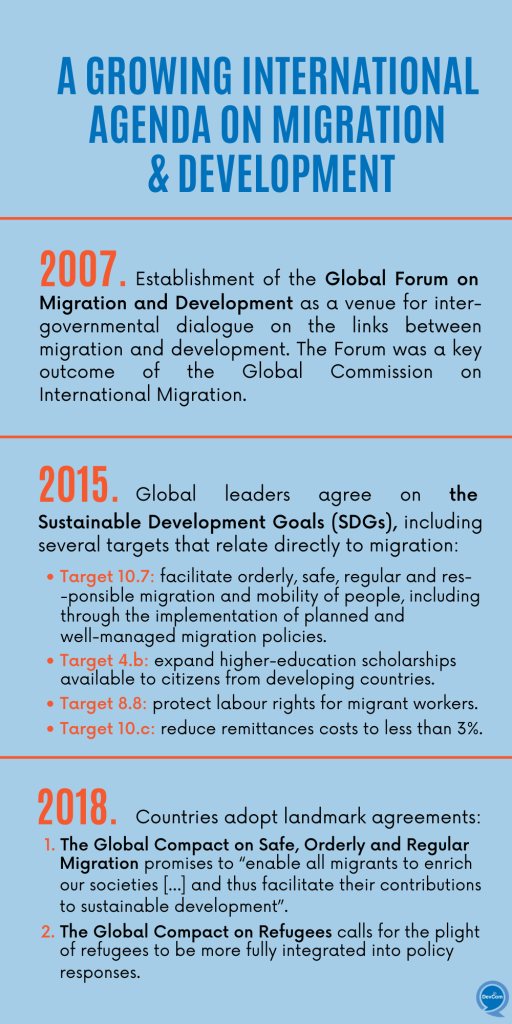
The OECD estimated in its November 2020 DAC Working Party on Development Finance Statistics Review that in 2018, members and partners of the OECD Development Assistance Committee (DAC) collectively spent USD 525 million of their official development assistance (ODA) on the “facilitation of orderly, safe, regular and responsible migration and mobility”. The EU accounted for half of this spending, followed by the United Kingdom (at 17%),Germany and Switzerland (at 11% each).[1] Many other DAC members have made migration a priority in their development co-operation policies, including France and the United States.
NARRATIVES ON MIGRATION AND DEVELOPMENT CO-OPERATION
Development organisations use diverse narratives to explain why they work on the issue of migration.
One set of narratives relates to the wellbeing of migrants, in particular refugees. Organisations highlight the material needs of migrants in distress, or focus on longer-term challenges for migrants, like integrating into new communities.
For development organisations, a second set of narratives naturally focuses on the impact of migration on development.
A third group of narratives focuses on the reasons why people leave their homes, calling for development co-operation to address the “root causes” of migration.
OPPORTUNITIES AND RISKS IN MESSAGING ABOUT MIGRATION
For us development communicators, there are very good reasons to communicate about migration. First, organisations are accountable for their work and have a responsibility to inform citizens about how they are spending public funds. Also, development communicators need to engage audiences and build public support for international development co-operation. Stories about migration make for powerful and emotional content, about harrowing journeys or heartbreak, about hope and overcoming the odds. They can also be relatable: about people leaving loved ones behind, seeking new opportunities to earn a living for their families, and finding their way in new communities.
Nevertheless, migration messaging bears major risks. The first risk is misinformation. Complex truths about migration and development are difficult to fit into a 240-character tweet, and intuitive reflections about migration are often false. For example, one might assume that as a country develops, people will be less inclined to want to leave their homes. The reality is much more complex. Research shows that development can lead to more migration, providing people with the resources and information needed to embark on their journeys.
Some people may also assume that emigration has mostly negative impacts on a country’s development prospects, for example by resulting in “brain drain”. Brain drain does affect smaller countries. However, emigration can also bring enormous benefits, like when emigrants acquire incomes, new skills and networks that they can deploy in their countries of origin, for example in the form of remittances. Of course, migrants can also have very positive impacts on development in their host countries.
Misconceptions are one thing. Stereotypes are another, and they are the second major risk in migration messaging. Everywhere in the world, certain groups of migrants are subject to hate speech, xenophobia and violence. In a divisive political and media landscape, they often become scapegoats for problems like unemployment and terrorism. By suggesting that migration is a phenomenon that must be stemmed, communicators further cast migrants in a negative light.
The terms often used to describe migrants may not help. Instead of using the term “illegal migrant”, many organisations now refer to “undocumented” or “irregular” migrants. While “irregular migration” has become a widely accepted technical term, suggesting that people are “irregular” could lead to lazy assumptions about who they are and why they left their homes.
The third and final big risk is that migration messaging can mislead citizens about the role of development co-operation. The OECD Development Assistance Committee (DAC) has strict rules on which spending its member countries are allowed to count as ODA. In short: development needs to be the main goal of all ODA spending.
Yet some migration-related spending appears to focus less on development and more on controlling migration flows, such as programmes designed to help countries develop their capacities for border management. While the DAC has launched a process to clarify what migration-related activities can be counted as ODA, civil society organisations warn that “ODA shouldn’t be used as a vehicle to promote providers’ migration interest”.
In this context, communicators need to think twice before suggesting that their organisation spends funds in order to stem migration flows. Many audiences will point out that this objective is not a legitimate use of scarce ODA funds, and will question the integrity of development co-operation. Moreover, even citizens that agree with this objective may lose trust: it is far from clear that development co-operation can actually have an impact on migration flows.
5 QUESTIONS TO POSE BEFORE POSTING
So how can we avoid the above pitfalls in our migration messaging? To answer this question, the OECD Development Communication Network (DevCom) decided to ask experts for advice. In June 2021, we brought together senior policy experts on migration and development, experienced campaigners and leading public attitudes researchers and asked them how they think development organisations should communicate about migration.
Based on the experiences and insights they shared, below are five questions that development communicators should ask themselves before messaging on migration. Under each question, readers seeking further guidance will also find useful links and resources.
Please contact us with your comments and examples at dev.com@oecd.org!
1. Does my message provide an accurate picture?
Our job as communicators is to simplify complex topics. However, given that migration is prone to fallacies and stereotypes, we need to make doubly sure that our simplifications do not mislead our audiences about migration and development.
At the same time, our quest for accuracy should not turn us into overzealous myth-busters. Research shows that by repeating a myth you’re trying to debunk, you actually give it more airtime.
If you want to get up to speed on migration and development, check out the following resources.

Funded by the European Commission, IOM has also developed a training guide – with clear videos on how migration can be brought into development co-operation.
–
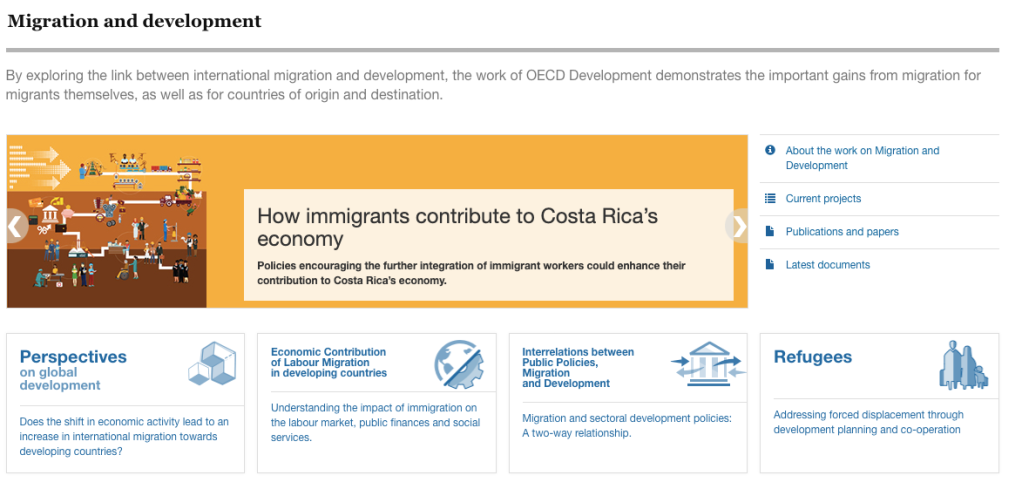
The OECD’s numerous projects, publications and papers on migration and development.
2. Is my message respectful?
Even well-intentioned messages can cast migrants and migration in a negative light. Words matter, and using words like “illegal” to describe migration immediately casts aspersions on the character of migrants. So does linking migration and development policy with domestic discussions about terrorism and crime. And regularly portraying migrants as “victims” who lack agency suggests that they cannot make positive contributions to society.
Many campaigns, including this IOM series of migrant stories, aim to highlight the positive contributions of migrants. They go beyond numbers, telling relatable stories about people with agency, skills, dedication, hopes and dreams.
One big challenge in this field is to highlight the contributions of migrants without focusing on them as “exotic” or as “superheroes”. We need to reinforce common values rather than reinforcing the “otherness” of migrants. Here are some resources to help you along the way:
- A guide created by the Global Forum on Migration and Development to help public sector organisations improve their narratives and framing on migration and development.
- ODI’s initiative on the role of migrant workers in the fight against COVID-19.
- A list of campaigns on migration assembled by DevCom’s sister network, the OECD Network of Communication Officers on Migration (NetCom).
3. Will my narrative hold up in the long term?
Building public support for development co-operation is a long-term effort. Narratives that seem enticing today may be counter-productive later. For example, using pictures of starving children may help NGOs raise funds in the short term, but, when shown repeatedly over decades, can convince audiences that those funds are ineffective.
When looking at migration and development cooperation, the “root causes” narrative may mitigate some audiences’ fears about immigration. Yet, as mentioned above, there are serious doubts whether development initiatives can actuallyhave an impact on overall migration flows. Moreover, the problems that will continue to drive migration in the long run — like climate change — are impossible for a development organisation to solve unilaterally. Even more importantly, as mentioned above, there are serious questions as to when development co-operation should seek to affect migration.
Drawing on our DevCom event in June, here are three recommendations related to the narratives we use to communicate about migration and development co-operation.
- Focus our communications on how our work on migration improves development outcomes, not migration outcomes. We can show how development co-operation helps countries draw benefits from both emigration and immigration.
- Don’t suggest that migration is unusual or undesirable. Migration is – and always has been – part of the story of humanity. Focus on challenges that development co-operation can address and highlight the solutions that our organisations bring to the table. For example, how does our work help countries fill skills or funding gaps in different economies?
- Focus on people, not numbers. As public attitudes research shows, we can engage audiences by focusing on how development co-operation supports shared human values, responsibilities and goals.
4. Who is my audience?
Our audiences do not fit into a neat box. Not all young people are pro-migration; not all rural folk are xenophobes. ODI finds that one individual can simultaneously harbour different – even seemingly contradictory – opinions about migration. For example, people can recognize the positive economic impacts that immigrants have on their country, yet still support reductions in immigration.
Strong opinions on migration are hard to shift. They are deeply rooted into an individual’s value system. If audiences appear more positive about migration today than in 2016, it may not be because their underlying opinion has changed, but simply because migration is less salient today than it was back then: the COVID crisis has brought other concerns into the spotlight.
However, there is still reason to be optimistic. ODI finds that a large proportion of citizens fit into a “conflicted middle” of people who may be receptive to our messages on migration. This group values things like conformity, family, freedom, fairness and “treating others as you want to be treated”.
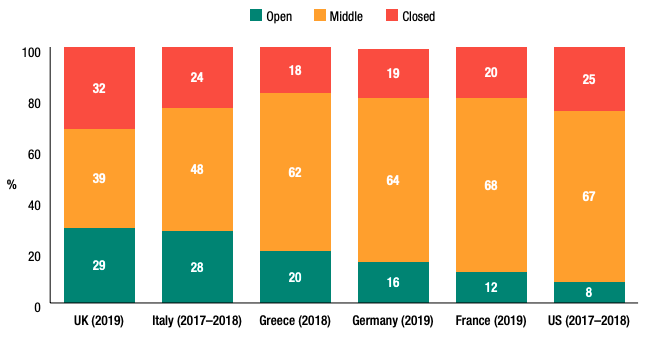
immigration and immigrants”
At our DevCom event, public attitudes experts agreed that, in order to reach these audiences, we need to engage with their values. For some experts, this means framing development work on migration as a normative or moral imperative. For instance, the UN’s Together Campaign seeks to combat xenophobia against refugees by showcasing their voices and their human stories. For others, it means making our messages more relatable and promoting empathy. Canada’s #Together4Venezuelans Walk Campaign seeks to showcase the astonishing lengths that Venezuelan refugees walk to get to safety by encouraging every Canadian to walk just 1% of their journey, while including a playlist for this walk of refugees relaying their harrowing journeys.
5. How will I find my audience?
A golden rule for all communicators today is to seek our audiences where they are, rather than expecting them to come to us. This may be doubly true in the case of migration messages that aim to engage audience on their values. Such messages need to be relayed from a point of trust, which public institutions in many countries currently lack (only 53% of people worldwide currently trust their governments).
Some simple ways to build confidence include translating more messages into local languages, or creating content that audiences can interact with (e.g. a Spotify playlist).
To achieve deeper impact, however, development communicators need to work with partners and messengers that enjoy greater trust and reach in communities. The It Takes a Community campaign, initiated by the Global Forum on Migration and Development, aims to do just this. It invites different stakeholder groups — including the private sector, youth, local governments and civil society — to “take over” the campaign and reach all corners of society with unique stories and perspectives. Download the toolkit and amplify the campaign yourself!
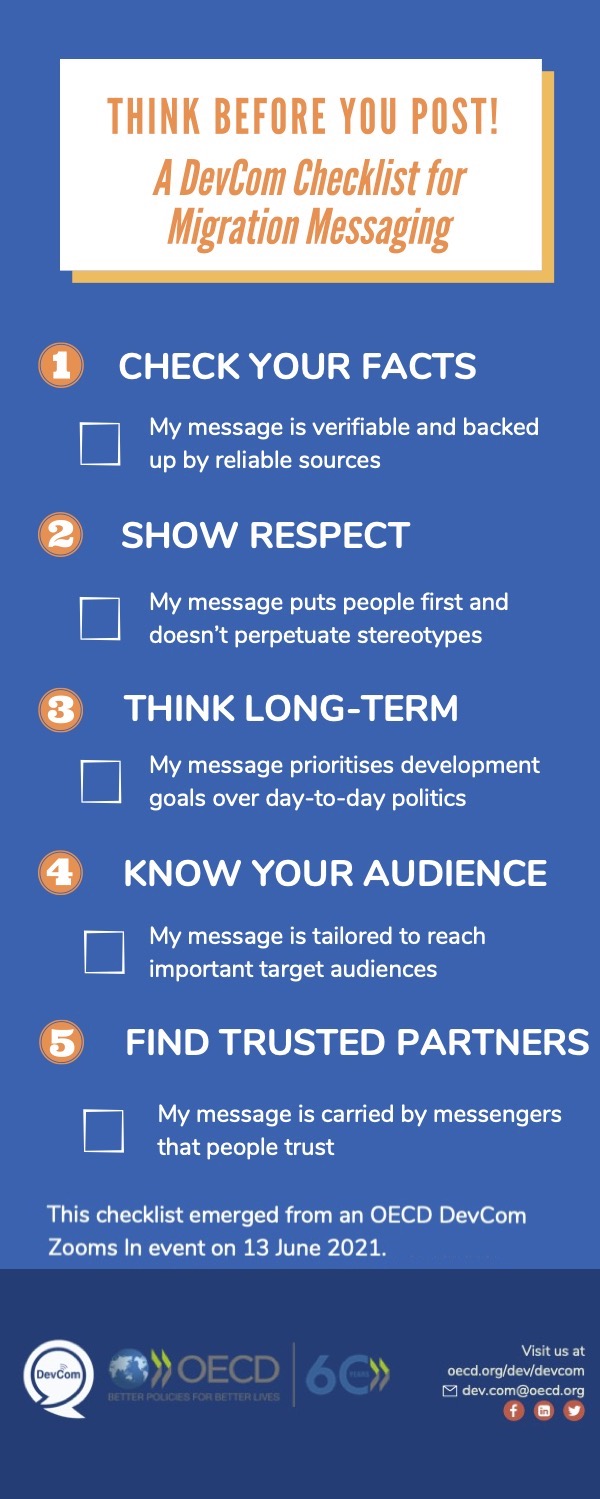
NEXT STEPS
Migration is a tricky subject for development communicators. We need to get the message right.
So, the next time that migration comes up in the news, or is part of the communications schedule for your organisations, please feel free to use our checklist for your migration messaging. We will share this checklist with members of the OECD Development Assistance Committee, including those policy makers who are currently defining which migration-related spending can count as ODA. We also look forward to working with DevCom members and partners in disseminating this list more widely ahead of International Migrants’ Day on 18 December 2021!
But first, we are eager to hear from you. Which of our principles do you think is most important and why? Which other campaigns and toolkits do we need to know about?
If you work in development communications, then please join the discussion on LinkedIn or contact us at dev.com@oecd.org.
[1] Source: DAC Working Party on Development Finance Statistics, “Review of the purpose code 15190 – Facilitation of orderly, safe, regular and responsible migration and mobility”, 16 November 2020.


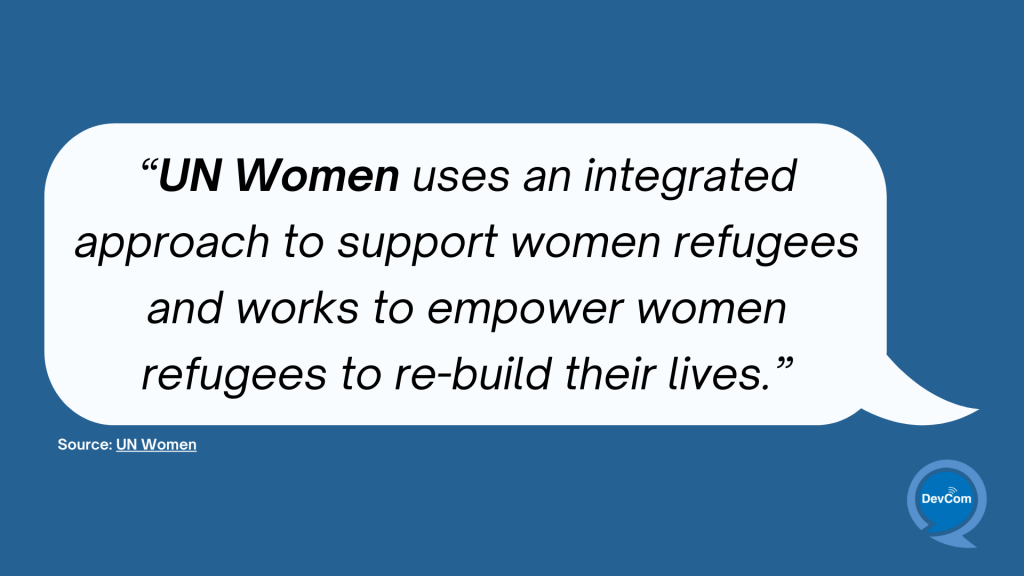


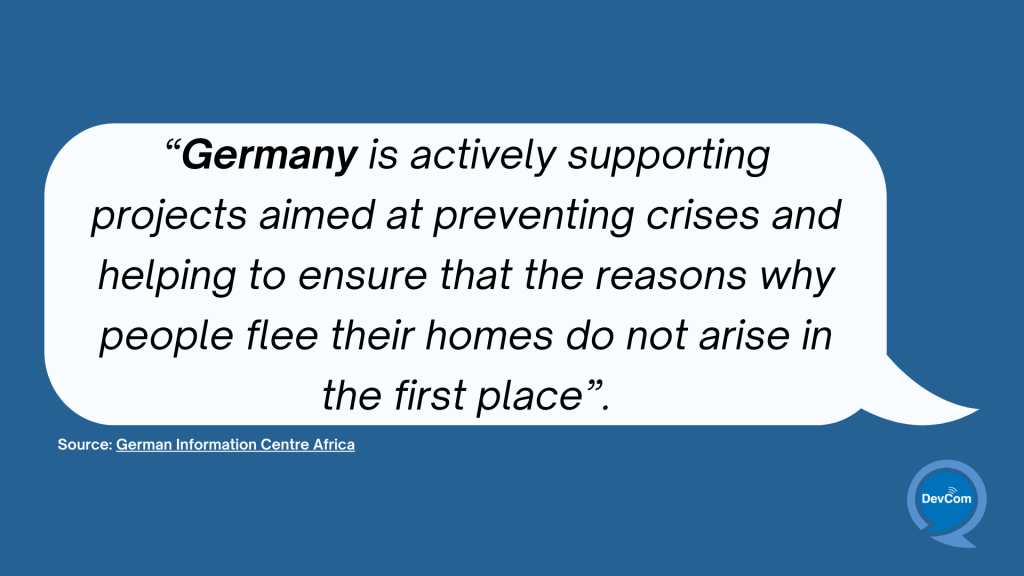
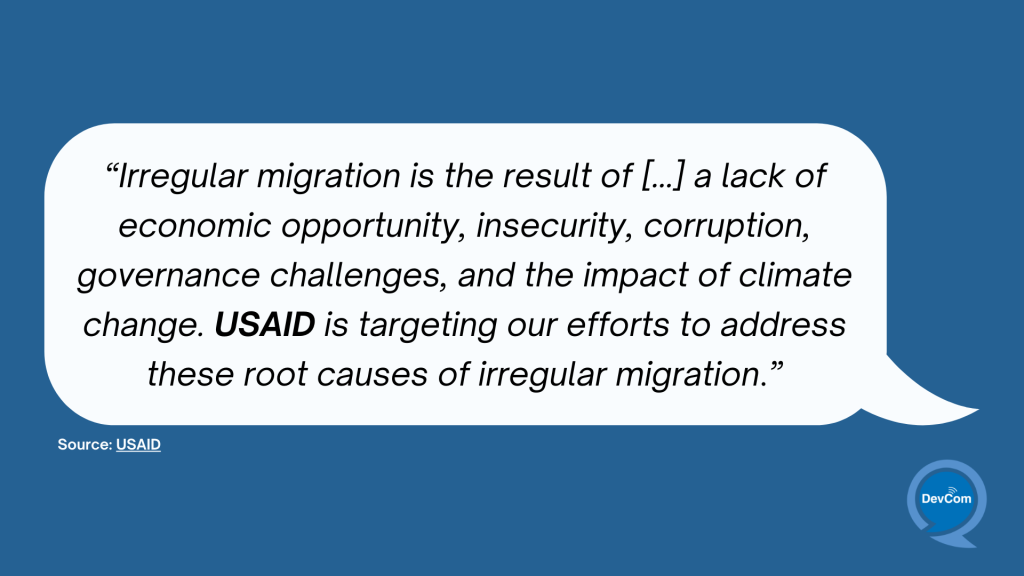
0 comments on “Communicating on Migration and Development: 5 Questions to Pose before Posting”